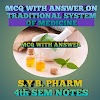EXPERIMENT NO.3. ANALYSIS OF AGAR BY CHEMICAL TEST
Aim: Analysis
of Agar by chemical tests.
Reference: 1. Mayur R. Bhurat, Md. Rageeb Md. Usman, Sanjay A. Nagdev, Practical Pharmacognosy & Phytochemistry – I, Published by S. Vikas And Company (Medical Publisher) page. No. 14 – 15.
2. Dr. K.R Khandelwal, Dr. Vrunda sethi, Textbook of Practical Pharmacognosy, Pubished by Nirali Prakashan, Twenty-fifth Edition, page. No. 27.1
Requirements:
Apparatus: Test
tubes, Beaker, Holder, Burner, Water bath, Tripod stand, Copper gauze etc.
Chemicals: o-naphthol,
Conc.H,SO,, Tannic acid, Potassium hydroxide, Ruthenium Red,’ Lodine,
Hydrochloric acid, Sodium hydroxide, Barium chloride etc. )
Theory: Biological
Source: It is the dried gelatinous substances obtained from Gelidium amansii
Lamouroux, and other species of red algae like Pterocladia.
Family: Gelidiaceae.
Description:
Color: White to
slight yellow and sometime grayish in color.
Odour: Odourless.
Taste: Mucilagenous
taste.
'Shape: Present
in various form like strips, sheets, flakes or coarse powder.
Solubility: It is
insoluble in cold water and soluble in hot water after cooling it forms gel.
Chemical Constituents: It
contains two heterogeneous polysaccharides components.
(a). Agarose (70%): It is a neutral
galactose polymer free from sulphate. It is responsible for the gel strength of
agar. It is composed of D-galactose and 3, 6 unianhydro L-galactose unit. It
contains about 3.5% cellulose and 6 % nitrogen containing substances.
(b) Agaropectin: It is generally
responsible for the viscosity of agar solution. An acidic sulphonated component
where in 1, 3 linked D-galactose and the galactouronic acid (an uronic acid) are,
partly esterified with sulphuric acid.
Uses: It is uses as a bulk laxative (an agent to induce active movement of the bowels) and in chronic constipation (unmanageable constipation), In the preparation of vaginal capsules and suppositories, To prepare nutrient media in bacteriological culture, In industrial applications like emulsion, sizing, silk textiles, adhesives and thickening ice cream.
Chemical Test of Agar:
|
SR.NO |
CHEMICAL TEST |
OBSERVATION |
INFERENCE |
|
A)
|
Preliminary
Test.
1. Colour
|
White |
Acacia, Tragacanth, Agar, Starch |
|
2. Odour
|
Odorless |
Acacia, Tragacanth, Agar,
Starch |
|
|
3. Taste |
Mucilaginous
|
Agar, Acacia, Tragacanth,
Starch |
|
|
B) |
General Test. 1. Mix small quantity with
water and allow to stand
|
Gummy or mucilaginous nature of drugs and does not dissolve completely. |
Gums & Mucilage, such as acacia, tragacanth, agar etc.
|
|
C) |
Solubility
in Alcohol |
Soluble |
Balsams, Aloes
|
|
Insolube |
Acacia, tragacanth, agar,
gelatin |
||
|
D) |
Insoluble in Alcohol. 1. Mount in alcohol & irrigate with water
|
Particles swell and ultimately
dissolve or become diffused |
Tragacanth, agar, gelatin.
|
|
2. Warm with caustic soda (5%) |
Canary yellow |
Agar, tragacanth |
|
|
3. Mount in N/50 iodine
|
No colour reaction |
Agar,
|
|
|
Blue specks appears. |
Tragacanth |
||
|
4. . Mount in ruthenium red
|
Stains pink
|
Agar
|
|
|
5. Boil about 1 part with 100
parts of water. |
Stiff jelly like mass on
cooling. |
Agar |
|
|
E) |
Confirmatory
Test: |
||
|
1. Sample solution (Hot) + BaCl2 reagents |
No Precipitate is formed |
Agar is present |
|
|
2. Sample solution + Fehling’s solution + Heat |
Red ppt. |
Agar is present |
|
|
3. Add 1 drop of N/10 solution of
iodine to, 10ml of decoction of agar: Rapidly cool under tap water to room
temperature. |
Crimson or Pale yellow colour is
produced ~
|
Agar is present
|
|
|
4. Incinerate agar to ash, add a drop
of conc. HCI, observe under microscope |
Fragments of diatoms |
Agar is confirmed. |
|
Result: The given
Sample of Crude drug was identified by performing chemical test and the sample
was found to be Agar.
















0 Comments
Please do not enter any spam link in the comment box.